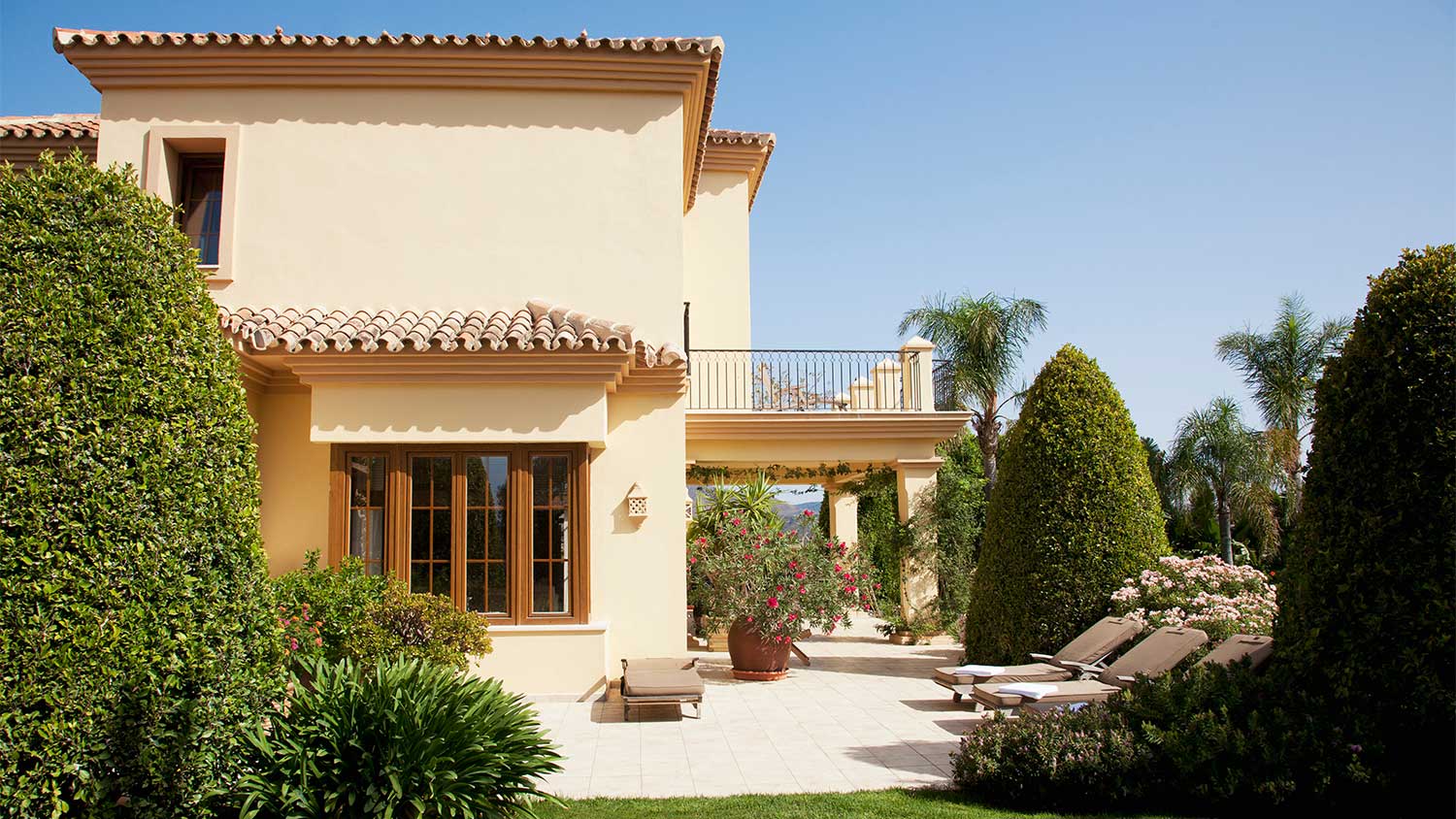Stucco vs. Wood Siding: Pros, Cons, and Costs
It’s a siding showdown between durable, laidback stucco and elegant, eco-friendly wood


Stucco siding is durable and incredibly long-lasting.
Stucco siding installation costs between $750 and $19,000.
There are many species and styles of wood siding.
Wood siding installation costs between $7,000 and $23,000.
Home siding takes a beating from wind, precipitation, and other outdoor elements. To reap the most value from a siding upgrade, it’s important to weigh your options and choose a material that will offer a considerable lifespan.
Stucco and wood are among the most popular siding options. Here’s how they measure up against each other.
Key Differences Between Stucco and Wood Siding
Stucco and wood siding are two very different materials. The key difference between the two is durability and aesthetics. Stucco is a more durable finish, but is prone to chipping and cracking over time. Wood requires more maintenance, but can be easier to repair.
What is Stucco Siding?

Originating in Ancient Greece and Rome, stucco siding has a rustic textured look and has long been one of the most popular options for home exteriors. Today’s stucco mixtures are usually composed of Portland cement, sand, limestone, water, and additives for strength and flexibility.
| Pros | Cons |
|---|---|
| Durable | Prone to cracking |
| Long lifespan | Porous |
| Low maintenance | Requires professional installation |
Best for: Homes in warmer climates
Pros of Stucco Siding
With one of its major components being cement, it may not come as a surprise that a revered feature of stucco is its durability. Stucco is highly resistant to fires and pests compared to wood.
Stucco is expected to last at least 50 to 80 years. If you live in a mild, dry climate, your stucco siding may last closer to 100 years.
Other than regular cleaning, stucco doesn’t require much upkeep, especially when compared to wood. You can keep your stucco siding costs fairly low after installation, only needing some power washing every few years.
Cons of Stucco Siding
Alongside the advantages of stucco, you must also consider the disadvantages.
Stucco’s rigidity can cause it to crack under the pressure of frequent changes in weather. Though the fix is fairly quick and affordable, cracks in your stucco siding can become quite the eyesore as they accumulate. Many stucco composites now contain glass fibers, acrylics, or other additives to promote flexibility. However, not all mixtures are made equal.
Stucco’s surface is absorbent, which can mean trouble if you live in an area with regular precipitation or high humidity. Stucco can retain moisture, creating dark spots along your home’s exterior and, in extreme cases, mold.
Unless you have a background in masonry, you will need to hire a professional to install stucco siding. Improper installation can lead to premature cracking and discoloration, as well as mold growth due to trapped moisture.
What is Wood Siding?

True to its name, wood siding is derived from trees. Cedar and pine tend to be the most popular types of wood siding because of their durability. They’re followed closely behind in popularity by oak and redwood.
| Pros | Cons |
|---|---|
| Natural aesthetic | Vulnerable to pests |
| Wide variety | High maintenance |
| Sustainable | Expensive |
Best for: Homes with a rustic or natural look
Pros of Wood Siding
Many siding materials attempt to mimic the texture and appearance that wood siding supplies naturally. If your home needs a boost in curb appeal, the warm, timeless look of wood siding might just be the move.
Your design options are virtually limitless with wood siding. Wood is easy to stain and paint, and is sold as clapboards, shingles, shakes, board-and-batten siding, and more.
Because wood is a renewable resource, incorporating it as home siding is considered an eco-friendly move. You can work with a local siding contractor to utilize even more eco-friendly resources, such as reclaimed wood.
Cons of Wood Siding
The pros and cons of wood siding come down mainly to maintenance and your ability to stay on top of repairs.
Many different insects eat and burrow in lumber. Though finishes and paint deter some pests, wood siding is still highly vulnerable to destructive insects like termites and carpenter ants.
Ongoing upkeep is essential to protect your wood siding from moisture infiltration, termite damage, and other problems. For starters, plan on painting or staining your siding every three to five years. It's common for neglected wood siding to warp, crack, or rot, so it’s imperative that you know the warning signs of siding issues to look out for.
Stucco vs. Wood Siding: Which is Better for Your Home?
When it comes to deciding between stucco and wood, you’ll need to consider your budget, your location and its climate, and your desired aesthetic.
Appearance: Wood
Stucco and wood have very different looks, so this decision comes down to your personal preference. That said, wood siding will give you many more design options.
Durability: Stucco
Stucco is dependable and strong and can even hold up to severe wind. High-maintenance wood siding, meanwhile, is susceptible to rot and is much more likely to be damaged by fire and pests such as termites. It’s also prone to warping and cracking.
Cost: Wood
Your house’s layout, existing siding, desired finish, and the supply and demand in your area will all influence the final cost. In general, wood siding costs slightly more than stucco since the material is much more time intensive to harvest and install.
| Material | Average Cost Per Square Foot |
|---|---|
| Wood | $3–$10 |
| Stucco | $7–$9 |
Lifespan: Stucco
Wood siding lasts an average of 20 to 40 years; its lifespan will depend on how well it’s maintained over time. Stucco, meanwhile, is expected to last between 50 to 100 years.






 - Jamie McInerney.jpeg?impolicy=thumbnail)







